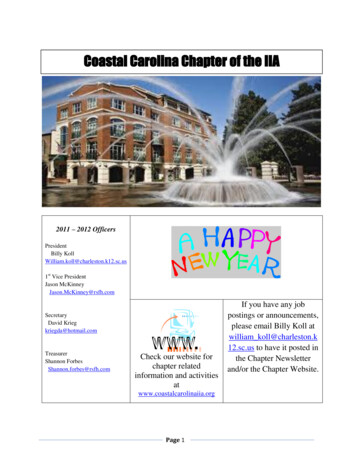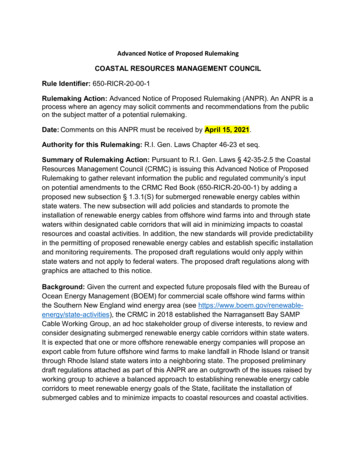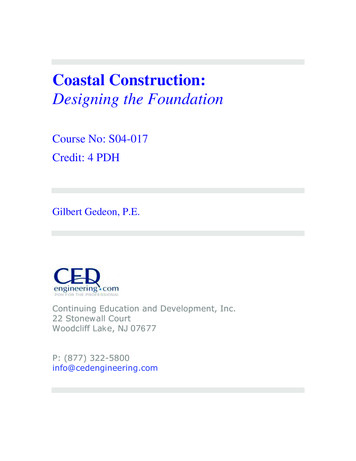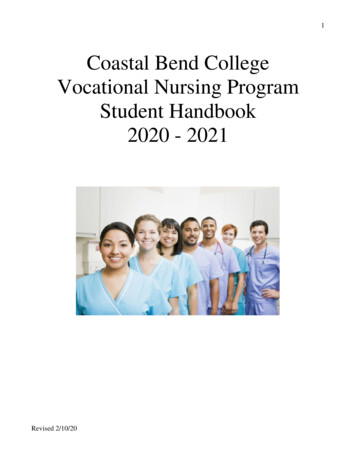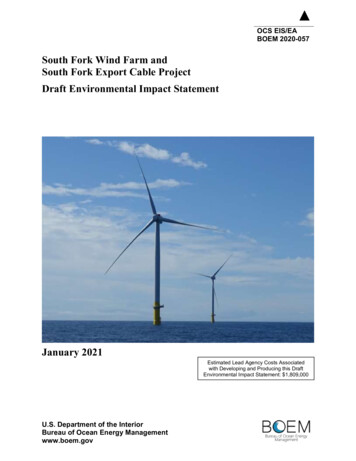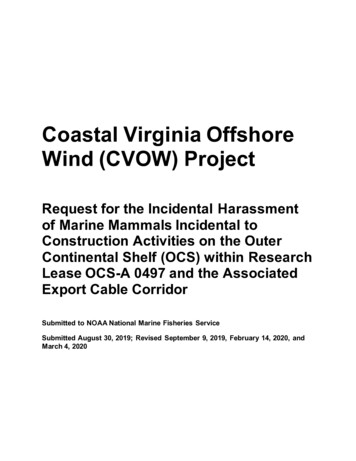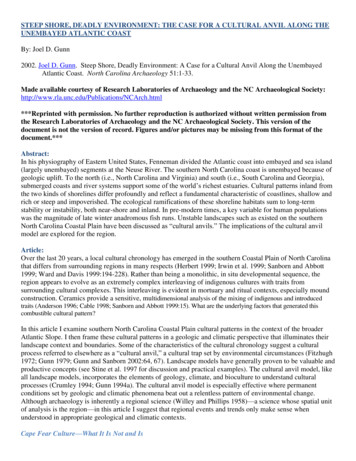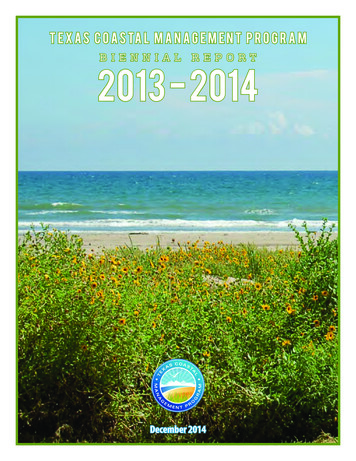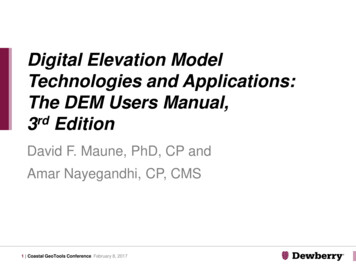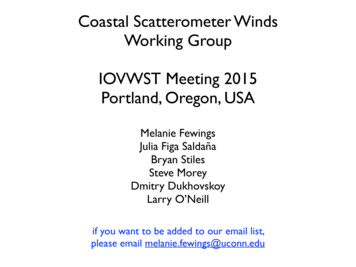
Transcription
Coastal Scatterometer WindsWorking Group!IOVWST Meeting 2015Portland, Oregon, USA!Melanie FewingsJulia Figa SaldañaBryan StilesSteve MoreyDmitry DukhovskoyLarry O’Neill!if you want to be added to our email list,please email melanie.fewings@uconn.edu
The Coastal Working Group currently has 3 sub-groups.2 groups are developing parallel SCIENCE and APPLICATIONS examples.!Each example indicates a need for higher Spatial and/or Temporalresolution of scat winds.!!1) Strong winds within a few km of the coastSteve Morey, Dmitry Dukhovskoy!* science questions:- How do wave-current-wind interactions affect storm surge? (S, T)- In landfalling storms, why does the wind field within 25 km of coast sometimesincrease and sometimes decrease? (S, T)* applications:- Coastal flooding forecasts & timing of peak storm surge relative to high tide (T)[regional models need scat winds every 90 min to avoid bias?]- Search and rescue (S, T)- Siting wind farms (S)- Oil spill trajectories/persistence (S, T)!
The eSurge programme incorporated scat winds and altimetry into storm surge forecasts.Operationaldemonstrationservice: eSurgelive (linked withGDACs)eSurge is the Storm Surge Demonstration Projecthttp://www.storm-surge.info/Funded by the ESA Data User Element ProgrammeBuilding adatabase ofstorm surgecases
Stefano Zecchetto uses scat winds to improve storm surge forecasts for Venice.eSurge-VeniceThe Data User Element (DUE) program of the European Space Agency (ESA) funded theeSurge-Venice project, aimed to demonstrate the improvement of the storm surge forecastingthrough the use of Earth Observation (EO) data and specifically focused on the Gulf of Venice(northern Adriatic Sea). eSurge-Venice had the following objectives: Select a number of Storm Surge Events and provide the EO, in situ and model data; Provide a demonstration NRT service of EO data in support of operational and experimentalforecasting and warning services; Run a number of re-analysis cases to demonstrate the usefulness of EO data.Scatterometer data were used to reduce the windspeed and direction biases between the modelledand observed wind fields, a technique called wind biasmitigation.The figure shows the results of the method over anumber of storm surge events (x-axis): the relative windspeed bias (top) and the wind direction bias (bottom)between the model and the scatterometer, before (opencircles) and after (solid circles) mitigation. Overall, therelative wind speed bias is reduced from 10% to 2%,and the wind direction bias from -5 to -2 degrees. Thewind bias mitigation brings improvements in the stormsurge hindcast.http://www.esurge-venice.eu1
1.20.6o0Wind Stress (N/m2)Ted Strubstudies what aspects of coastal storms are (not) resolved by existing scat data.PORO342.74 CC1o41.75 N0.60-0.61.2HBYC10.640.77oN0-0.65678Feb 20159Extreme Coastal Wind Events:What Doesn't the Scatterometer See?X1 Rapidscat V1.1 winds 02/09/2015 08:39:12 rev # 02157and winds interpoalated between coastal CMAN & scatterometer (blue)1011ASCAT A winds 02/09/2015 18:46:25 rev # 43119X1 Rapidscat V1.1 winds 02/09/2015 02:28:55 rev # 02153and winds interpoalated between coastal CMAN & scatterometer (blue)46oN46oN46oNP. Ted Strub & Corinne James45oN45oN44oN44oN45oN44oN43oN43oN43oN10 m/s10 m/s10 plex0126oW125oW124oW123oWo129 Wo128 Woo127 Wo126 W125 Wo124 W128oW127oW126oW1020m/s20m/s3001020m/s30124oW123 W010125oWo30123oW
!2) Atmosphere-ocean coupling within 50 km of the coastLarry O’Neill, Melanie Fewings!* science questions:- Does SST-wind coupling in coastal upwelling regions enhance or suppress upwellingand relaxation events? (S, T)- In wind features tied to orography, how does the SST-wind coupling differ from the 1-waycoupling assumed in the open ocean? (S, T)- Does SST-wind-current coupling at submesoscale features like fronts and filaments lead toenhanced upwelling on small scales? (S, T) [models are ahead of observations]- In productive island wakes, is upwelling due more to wind wake or oceanic wake? (S, T)!* applications:- Fish catch enhanced at fronts (S)- Hypoxia and fish die-offs in upwelling systems (S, T)- Nutrient supply to fisheries via submesoscale features (S, T)!!!Talks in this session:!Fabien Desbiolles - Impact of fine-scale wind stress curl on coastal upwelling (Benguela)!!!other possibilities:Polar lows (not coastal)Sea ice
A 3rd sub-group pursues the production and use of coastal scat products withglobal coverage.!3) Methods for improving Scat resolution near coastJulia Figa-Saldaña, Bryan Stiles!* Methods for producing “coastal” products from existing missions:- Coastal ASCAT (Eumetsat/OSI-SAF) (S)- NOAA coastal products (S)- Stiles et al. QuikSCAT/OSCAT/ASCAT product in progress (S)!* How should “coastal” products be validated?Need global product so many users can validate it regionally against buoys, land winds, etc.!* Future missions:- Advocate for little/no on-board aggregation to permit high-resolution reprocessing (S)!!Talksin this session:!Ad! Stoffelen - Highlights of the ASCAT high-resolution processing workshopAlexFore - Bringing winds closer to the coast with QuikSCAT and RapidSCAT!
Richard Lindsley, Craig Anderson, David Long, Julia Figa Saldaña, Ad )Measurement)Spa al)Response)Func on))(in)prepara ta on)
Richard Lindsley and David Long parameterize the ASCAT spatial response function,use “land fraction” to assess contamination, and retrieve wind within few km of the Frac:on%Thresholding% Near*coastal%backsca ng%poor%winds% nated%backsca er%measurements% nd%error% ew%kilometers%of%the%coast,%be er%with%UHR%%BYU%R.%Lindsley%and%D.%Long%
Jur Vogelzang and Ad StoffelenASCAT product improvementsAveragingareaJur VogelzangAd StoffelenKNMI Figure shows centers ofantenna footprints (redcrosses) contributing toWVC (black squares) inASCAT-coastal Low density in midbeam at smallincidence Define more optimalWVC’s w.r.t. footprints
Steve Morey combines scat wind & numerical model in a global index of coastal upwellingAn Improved Scatterometer Derived Global CoastalUpwelling Index Database Steve Morey (FSU)Global scatterometer derivedwind products are used toproduce a database of upwellingindices for all coastal regions.This database is analyzed tocharacterize spatial andtemporal variability of upwellingin different regions.Numerical model results are analyzed to developa modified method of computing upwellingindices that improves the relationship betweenthe index and cross isobath upwelling in coastalregions with complex topography. This imageshows an example of the improvement incorrelation between upwelling index and nearbottom cross isobath flow when using themodified index versus the classic upwelling indexcalculation.
Steven Lohrenz (UMassD) and collaborators: Using satellite winds to estimate air-sea CO2 flux.Wind availability is a limiting factor in coastal regions, where pCO2 variation is naturally ysis'Satellite6derived'pCO2'CCMPwindsF ks Satellite'derived'air6sea'CO2'flux'
Coastal Scatterometry Working Group!!Discussion suggestions:!!1) Goals: come up with- “good stories” in anecdotal form rather than science form- (multi-platform) climate applications in coastal regions!2) Future collaborative projects!!3) Problems that need to be addressed
X1 Rapidscat V1.1 winds 02/09/2015 08:39:12 rev # 02157 and winds interpoalated between coastal CMAN & scatterometer (blue) o o o o o 0 10 20 30 0 m/s 43 o o o 129oW 128 oW 127 oW 126oW 125oW 124W 123oW 41oN 42oN 43oN 44oN 45N 46oN 41 o o 10 m/s ASCAT A winds 02/09/2015 18:46:25 rev # 43119
